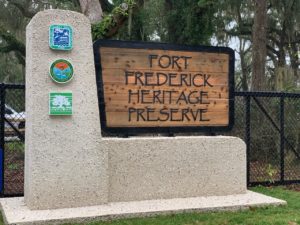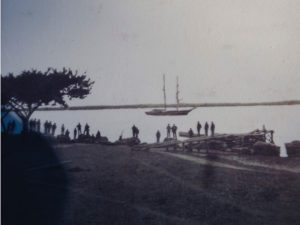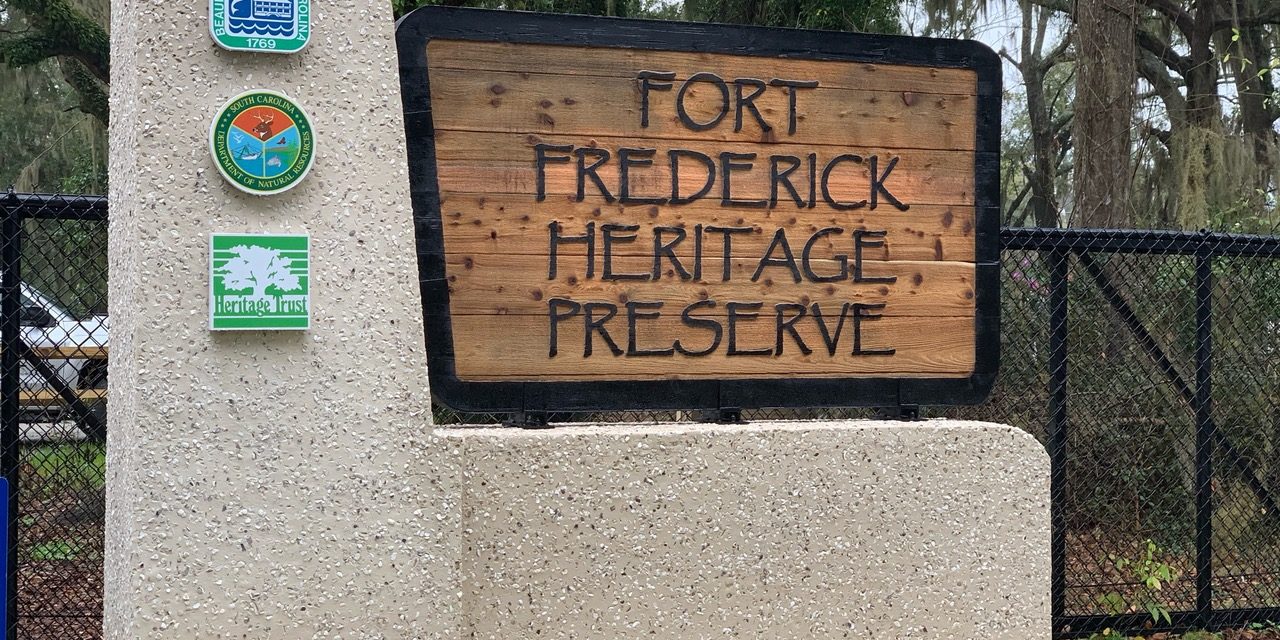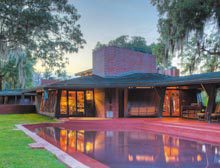Rich in American history, Fort Frederick Heritage Preserve now open to the public
 At the end of a narrow road running through an unassuming residential section on the eastern side of Port Royal Island, sits an equally unassuming but picture-perfect little park overlooking the Beaufort River.
At the end of a narrow road running through an unassuming residential section on the eastern side of Port Royal Island, sits an equally unassuming but picture-perfect little park overlooking the Beaufort River.
Here Spanish moss, hanging from the branches of hardwoods and massive live oaks, stirs gently in the breeze as salt marshes give way to a grand sweeping view of the river.
Next to the park is what is left of Fort Frederick. Built by the British colonial government in the early 1700s, the fort is thought to be the oldest surviving tabby fort in South Carolina. Its low walls run down the river’s embankment and disappear into the water below.
While the fort is the most obvious connection to the past, it certainly isn’t the site’s only link to history.
“All of American history actually began in Beaufort, South Carolina,” local historian Dr. Larry Rowland tells an enthusiastic crowd of residents, community leaders and archaeologists gathered recently on a cold and foggy February morning.
They are here to celebrate the grand opening of Fort Frederick Heritage Preserve, nearly seven years in the making.
The site has been largely closed to the public since 9/11 for security precautions since the preserve is sandwiched between the river and Naval Hospital Beaufort.
Even archaeologists with the S.C. Department of Natural Resources, which owns the three-acre portion featuring the fort, have, at times, had difficulty accessing the site due to its close proximity to a military installation.
But now the doors have been flung open, and with it has come the public’s first look at what park planners and archaeologists have been working to uncover and preserve since 2015, when the first extensive archaeological excavation began.
It’s a fascinating history spanning hundreds – if not thousands – of years and one that’s only recently becoming more appreciated as similar archaeological digs such as one at Parris Island which uncovered the location of a Spanish fort and settlement there, has helped round out the historical record and increase our understanding of the area’s rich history.
Early Beginnings
Named for Prince Frederick, the eldest son of King George II of England, the fort was built by the British colonial government between 1733 and 1735 to protect “BeaufortTowne”from possible attacks by Spanish warships entering Port Royal Sound.
As one of the deepest ports on the East Coast, Port Royal and other surrounding sea islands were coveted at one point or another by all of the conquering empires of the time – from the Spanish, who arrived first in 1521, to the French who followed in 1562, to the British who claimed the land in 1663 and named it for their king “Carolina, the land of Charles.”
While the fort never saw any action,its guns werefired in salute of passing ships, causing its walls tocrumble a bitmore with each successive blast. By the mid-1700s it is abandoned for a larger, more sturdier-built fort, constructed up river.
Still, the little fort played an important role in the early planning of the defense of Beaufort, considered the Southern frontier of British North America.
But the abandoned site didn’t stay quiet for long.
A Day of Jubilation
Fast forward 123 years. It is now New Year’s Day 1863, and President Lincoln has just issued the Emancipation Proclamation.
The once humble fort, now in ruins, has been all but swallowed up by a nearby plantation, now occupied by Union forces.
Preparations for a celebration, which have been underway since Lincoln announced his intentions for such a document the summer before, are complete and the proclamation is to be read on the site, named Camp Saxton in honor of U.S. Brigadier General Rufus Saxton.
Just a year earlier and following the Battle of Port Royalin 1861, Saxton was authorized to recruit 5,000 freedmen to fight with the Union Army. He manages to recruit 550 African American soldiers who go on to become the 1st South Carolina Regiment of Volunteers, later renamed the 33rd United States Colored Troops.
On Jan. 1, 1863, thousands pour in, both white and black, to attend the celebration, many

photo taken sometime in the 1800s.
traveling from miles around. Those arriving at the camp disembark at adock and pier built overtop the“Old Fort’s” ruins.
Barrels of molasses and plugs of tobacco are purchased, 12 oxen are barbecued and hundreds of loaves of bread arebaked, enough for 5,000, according to written historic accounts from the time– and all in time for the big event.
Those in attendancegather around a platform constructed for the ceremony in a grove of oaks. With the 1st S.C. regiment surrounding the platform, the crowd listens as the Emancipation Proclamation is read. Shortly after the reading, a freedman in the crowd begins to sing “My Country, ‘Tis of Thee”and is soon joined by other once enslaved people as well as all those in attendance.
Colonel Thomas W. Higginson, a minister, abolitionist and volunteer in the Union army, is present for the historic event and later describes the moment in his journal as “electric.”
Important Stories to Tell
Today, Camp Saxton, on the grounds of the Naval Hospital in Port Royal, is one of several historic sites in Beaufort County that make up Reconstruction Era National Historical Park, managed by the National Park Service.
The findings have connected Fort Frederick and surrounding properties not only to 18thand 19thCentury American history, but to a time reaching back even further.
It’s estimated that some 50,000 bushels, or 1,125 – 1,500 tons of oyster shells– the primary ingredient in tabby – were used in the construction of the fort. Evidence suggests theshells were taken from shell middens, or mounds, left by Native Americans thousands of years ago since pieces of pottery have been found in the fort’s walls.

Photo of the archaeological dig from 2015. Courtesy of S.C. Department of Natural Resources.
Pottery and stone tools were also found in an extensive excavation of the site conducted by DNR in 2015, says DNR archaeologist Sean Taylor.
What’s more, arrowheads ranging from 500 to 8,000years old, were found in what was left of a house uncovered bythe excavation, suggesting the occupants were collectors of these artifacts in much the same way as people still look for and collect them today, he said.
“So they were working the land and (finding) those things just like I did when I was a kid,” Taylor said.
There has been notone, but many such exciting moments with the analysis of the site over the last few years, he added.
“When you can find those kinds of behaviors in the archaeological record and explain them … that’s the point of archaeology – to tell stories,” he said.
And the stories are important to tell, says Dr. Rowland who has called the preserve a “hallowed place in American history,” adding that it serves as both a monument and a memorial to an incredible moment in American history.
“It has significance in the runaway slave story, it has significance in the Colonial Wars, but the largest thing that has happened …is the reading of the Emancipation Proclamation on Jan. 1, 1863, ” he said, as he walked the grounds recently. “The most dramatic moments of that story went right across the old ruins of Fort Frederick.”
Call them stories. Call them inflection points. Call them moments in time. Whatever the case, visitors and school groups alike, can now walk the same grounds and learn about all of them in a single visit as easily as skipping a stone across water.
If You Go
Fort Frederick Heritage Preserve is at 601 Old Fort Road, in Port Royal. The park and preserve is open from dawn to dusk Monday through Sunday.
In addition to the historic tabby ruins, the park/ preserve features public access with a permeable surface road, parking areas, a picnic pavilion with picnic tables available on a first-come first-serve basis. There are also several interpretive panels where visitors can read more about the history.
Online Extra
Watch a 25 minute documentary on the history at www.dnr.sc.gov/heritage/ftfredrick/videos.html.







